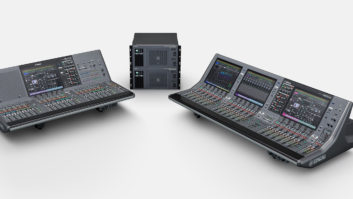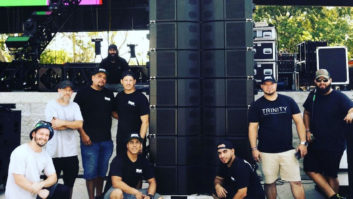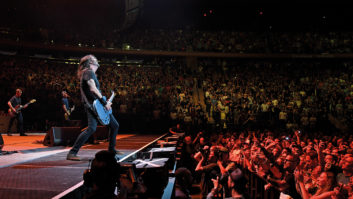LOS ANGELES, CA—Cirque du Soleil’s Toruk—The First Flight, an immersive live multimedia spectacle inspired by James Cameron’s 2009 blockbuster movie Avatar, has been touring arenas throughout the United States and Canada since November 2015, and is currently scheduled to run through late March 2017. Production provider Solotech is along for the journey, supporting show sound designer Jacques Bouchard’s vision of delivering a 360-degree audio environment at every venue.
The show is set on Pandora, home world of the blue-skinned Na’vi, centuries prior to the movie. It tells the tale of a quest for five totems that will lead the main characters to Toruk, a giant red bird that can save their clan’s sacred Tree of Souls from destruction.
The action takes place on a circular stage surrounded on three sides by the audience, above which five arrays of 12 L-Acoustics Kara modules each are flown around a central canopy. Additional arrays of L-Acoustics ARCS II and 115XT provide fill for the audience seated between the stage and the proscenium entrance at the far end of the venue. Low end is delivered via cardioid arrays of SB18 and SB28 subs beneath the stage and behind the proscenium.
Marc L. Depratto, Solotech’s project and maintenance manager on the production, reports, “We’ve also got two hangs of four K2s on each side that are mainly used as effects speakers. We use the K2’s Panflex adjustable horizontal directivity to give us asymmetrical coverage, to keep the sound off the walls. Since they’re mostly used for effects, Jacques wanted a speaker that is very beamed so that you hear localization of the source.”
The Kara modules derive their power from a pair of LA8 amplified processors custom-mounted atop each bumper by Solotech. The rest of the L-Acoustics rig is driven by LA4 and LA8 units located in large racks on the upper decks of two backstage towers that also house some of the show’s props.
Eight pods of either two or three Meyer Sound UPA cabinets each are flown around the auditorium’s outer perimeter for effects and to support an enveloping soundscape. At the Staples Center in Los Angeles, an additional UPA array filled a gap not covered by the K2s. “Because of the cable length, they opted for self-powered speakers,” says Depratto.
At front-of-house, music playback engineer Bruno Dumont selects cues from 200 pre-recorded tracks in Ableton Live, feeding them to head of sound Glen Beckley via MADI. Operating Meyer Sound’s LCS CueConsole plus an Avid Venue SC48, Beckley drives 42 outputs from Meyer Sound’s D-Mitri 96 kHz, 32-bit digital audio processors in the backstage racks to the immersive speaker rig.
Console inputs and output drive lines travel back and forth as AES signals over fiber. Backstage, D-Mitri outputs travel via a Riedel Rocknet network over Cat 5 cables, together with power, to a control rack in the ceiling and out to the five main Kara arrays. There is an analog 24-pair backup. “But we have never had to use it, and we’re almost 300 shows into the tour,” says Depratto.
Bringing sound to the world of Pandora are (l-r): music playback engineer Bruno Dumont; Marc L. Depratto, project and maintenance manager; head of sound Glen Beckley; and Jeff Eben, PA tech and playback backup engineer.

“We use the track that flies the Toruk as a cable track,” he adds. “The rig is divided into two zones, so every Kara array is a top zone of six and a bottom zone of six speakers.
“Every character mic has its own discrete input into the [LCS] matrix,” says Beckley, “so we can audibly position the character in line with where they physically are. Because all the puppeteers wear microphones and make animal noises, we treat them more as part of the sound effects soundscape than as a miked performer. You hear their panning moving around quite a bit.”
In addition to the 32 music cue tracks, Beckley handles 14 channels of Sennheiser wireless mic inputs from the puppeteers, two musicians and the show’s onstage narrator, plus some handhelds and returns. Many pans are performed manually, but, he says, “There are a lot of video cues locked to the video projection images with timecode, so I can use those to automate certain elements.”
Much of the action occurs on the stage. “When dialog or singing is happening on the island, we keep the audio focused on that,” says Beckley.
Jeff Eben, PA tech and playback backup engineer, has the unenviable task of providing Beckley with an image of the rig at his mix position, which is in a different location at every arena, and rarely at front-of-house. “There’s a lot of spatial movement. There are effects panning through the Arcs, through the five Kara arrays and around. If we need to be upstairs, like here, the image goes out the window. I try and give Glen a tuning that is as representative as possible of what’s going on downstairs,” says Eben, who applies “a good chunk” of EQ to the system at the D-Mitri processors.
“It’s probably more about manipulating the image than it is about mixing the music,” says Beckley. “It’s a case of creating the different elements; then the job of mixing the show is more a case of making it all fit together in a consistent way. It’s a different discipline. Nothing beats mixing a great-sounding band, but this is a good workout for the gray matter.”
Solotech
solotech.com
L-Acoustics
l-acoustics.com
Meyer Sound
meyersound.com







